|
Please be patient while images load. FORT WAYNE RAILROAD CLUB |
|||||||
_765_CollinsvilleOH.jpg)
|
In this lamentably
dusty shot, the Fort Wayne Club's restored Nickel Plate
Road 2-8-4 number 765 hammers along Norfolk &
Western's single-track main through Seven Mile Creek
Valley on her way home from Cinicinnati. With white
"extra" flags snapping in the wind, her banshee
whistle and crack-crack-crack exhaust let everyone know
it's time to get out of the way! This NKP Berkshire type is typical of a large group of superpower engines produced by the Lima Locomotive Works during the early 1940s. Nearly identical locomotives were acquired by the Chesapeake & Ohio, the Erie, and the Pere Marquette railroad companies. Designed for fast freight service, they could also perform in passenger service at 70 miles per hour. Bringing up the rear of this circa 1980 fan trip is a track inspection car, a modified open-platform observation of 1920s vintage. |
|||||||
|
Please be patient while images load. NORFOLK SOUTHERN
|
|||||||
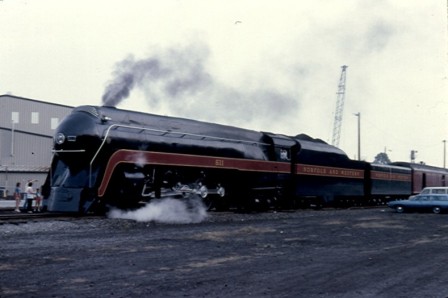 Norfolk & Western class J (4-8-4) No. 611, built 1950 Ludlow, KY (1986) |
 Norfolk & Western class A (2-6-6-4) No. 1218, built 1943 Ludlow, KY (1987) |
|||||||
On the right, a close-up of the valve gear on 1218's lead engine reveals one reason for the relatively low maintenance needs of modern steam power. Note the power lubricator linkage just above the crosshead. This ensures a constant supply of lubricant to sliding surfaces, which in older engines had to be manually oiled at station stops. Such innovations significantly extended both cruising range and time between shoppings for modern steam. |
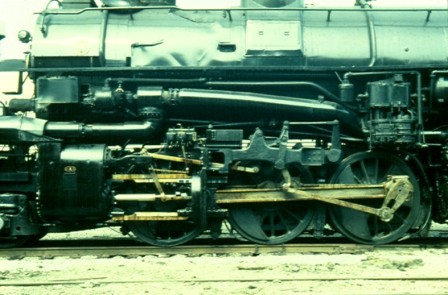 |
|||||||
|
||||||||
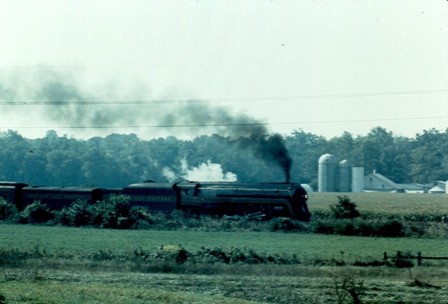 The 611 churns past farmland north of Hamilton on her way from Cincinnati to Fort Wayne. Steam erupts from her 5-chime whistle as she announces the upcoming US-127 grade crossing. |
||||||||
Number 611 hustles the Bluegrass Special southward from Cincinnati. Once out of the Ohio River Valley, this anthracite-munching racehorse stretches her gait and makes herself at home. Although the J's drive wheels are only 75 inches in diameter (compared to 80-inch drivers typical of 4-8-4s on other railroads), precision-balanced roller-bearing rods enable her to roll at100 miles per hour on the flat. Manufactured in N&W's own Roanoke shops between 1941 and 1950, the fourteen streamlined 600s were among the last steam locomotives to be built for class-one service in the United States. |
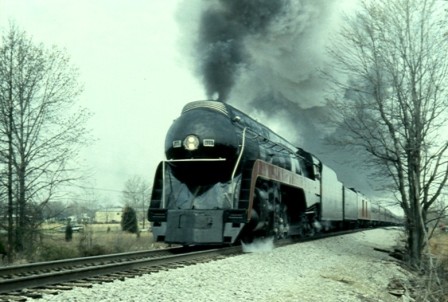 |
|||||||
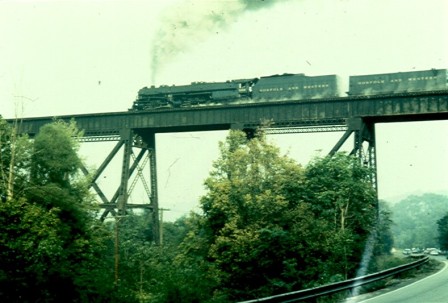 Her own syncopated exhaust sounding the drumbeat, 1218 marches smartly across the Erlanger trestle, on her way south out of Cincinnati... 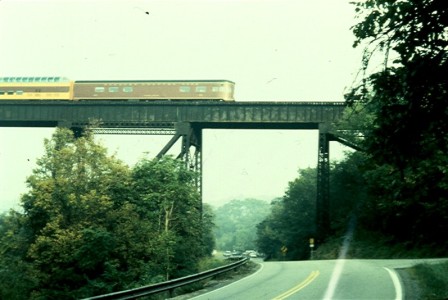 ...bound for Danville, with a 30-plus-car consist capped by a couple of twelve-wheelers—a Milwaukee Road full-length dome car, and Norfolk Southern's round-end observation car Mardi Gras. |
||||||||
|
||||||||
|
|
|||||||
_obs_ColliinsvilleOH.jpg)